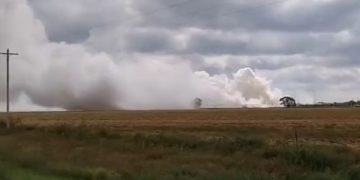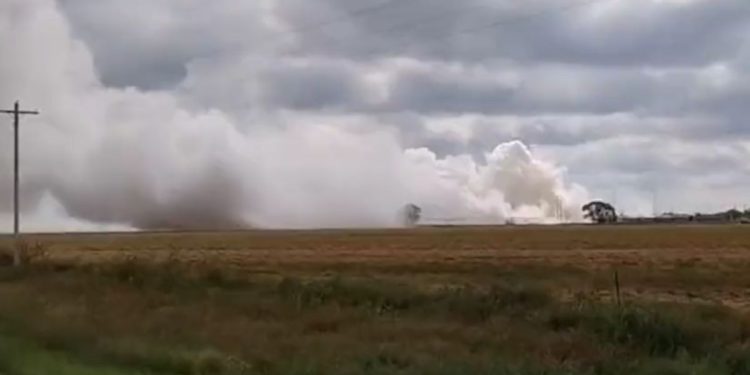A massive explosion at a vast freight yard in North Platte, Nebraska, forced evacuations Thursday.
The fire broke out in an intermodal container parked at Union Pacific’s Bailey Yard, railroad spokeswoman Robynn Tysver said, according to the Associated Press.
Evacuations were ordered within a one-mile radius of the fire, which sent thick toxic smoke into the sky.
The fire erupted at about noon, but by early evening, the evacuation order was rescinded. The Daily Mail said the evacuation zone had a four-mile radius at one point.
The container where the fire began contained perchloric acid, which is used in explosives as well as a variety of food and drug products, Tysver said.
An explosion inside a shipping container at the world’s largest railyard prompted evacuations in western Nebraska Thursday because of the toxic smoke generated when one of the chemicals aboard caught fire. https://t.co/8Fo18wKSSA
— Sharon K. Gilbert (@sharonkgilbert) September 15, 2023
Tysver said the car had not been moving at the time of the incident and that no derailment took place within the vast yard, which is eight miles wide at one point.
Gregg Robertson, a volunteer at an observation tower known as the Golden Spike Tower told the North Platte Telegraph he was in the middle of a conversation when “I just saw something and I looked and it was just a big ball of flame.
“And then it was just fire, fire, fire, constant for 10, 12 minutes, maybe. And then the fire went down and smoke kind of increased, and then it was just sparks coming out,” he said.
?#UPDATE: Aerial footage reveals the toxic train car that caught on fire and exploded at the North Platte Union Pacific railyard. Officials report that the burning container held a dangerous chemical called perchloric, which is used in various applications like food, drugs,… pic.twitter.com/OfZS80zTQx
— R A W S A L E R T S (@rawsalerts) September 14, 2023
Two plumes went skyward, he said.
“The east plume was like black smoke. The west plume was orange smoke, something like I’ve not seen from a fire,” he said. “There’s something was burning that — I don’t want no part of smelling what it was, because it was some kind of chemical over there going on.”
Area resident Charlie Morland told the Telegraph a person did not need to be in the yard to be aware of the blast.
“It just shook the ground. You could feel it shake the vehicles and stuff. I knew it was a pretty violent explosion,” he said.
Although rail safety has been a concern since a Norfolk Southern train derailed in East Palestine, Ohio, earlier this year, causing lingering environmental issues, North Platte Fire Chief Dennis Thompson said Friday there appeared to be limited damage from the fire, according to the Associated Press.
“Especially when we look at some of the incidents that we’ve seen recently around the country, this just couldn’t have gone any better. When we leave these things with no injuries or significant damage or loss of equipment or anything, or environmental impact, it’s a win by all means,” he said.
The perchloric acid dissipated as it burned off, Thompson said, adding that air and soil monitoring showed no dangerous levels of the chemical. He said a second container that burned likely contained memory foam.
Although Thompson sought to minimize the extent of the damage, the incident came only weeks after Federal Railroad Administrator Amit Bose wrote Union Pacific executives to highlight the number of defects in freight cars and locomotives at the North Platte railyard, according to the Associated Press.
The letter called the defects a “significant risk to rail safety.” It said 19.93 percent of UP rail cars had defects, as did 72.69 percent of locomotives. Although the letter said the rates from inspections in July and August were twice the national rates, it did not provide details about the defects.
“The compliance of the rolling stock (freight cars and locomotives) on the UP network is poor, and UP was unwilling or unable to take steps to improve the condition of their equipment,” Bose wrote.
This article appeared originally on The Western Journal.

























